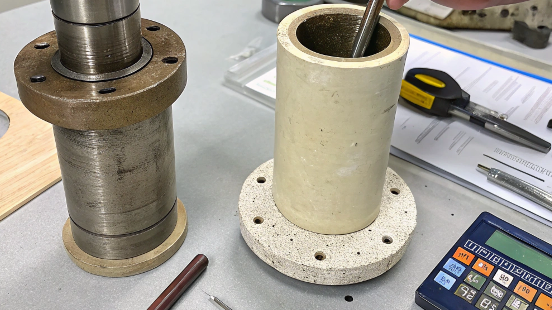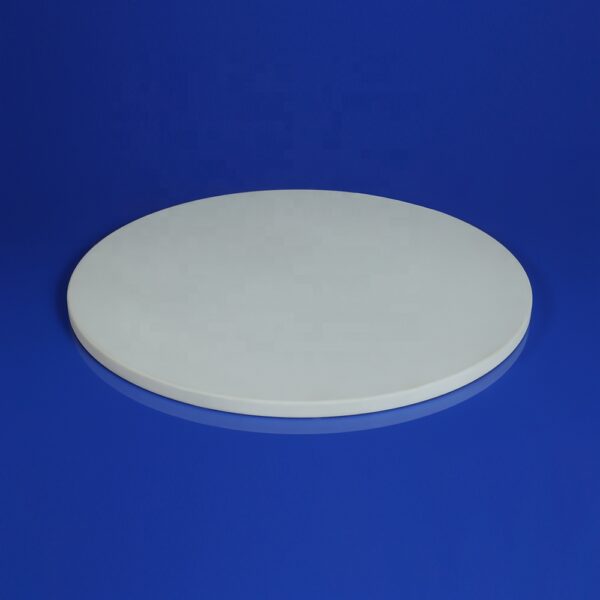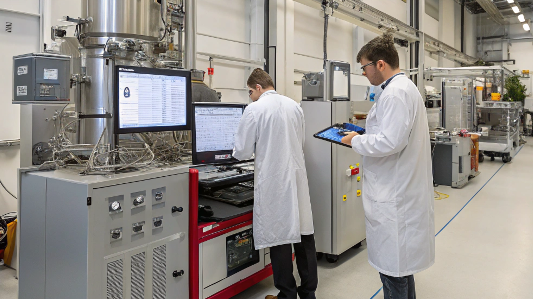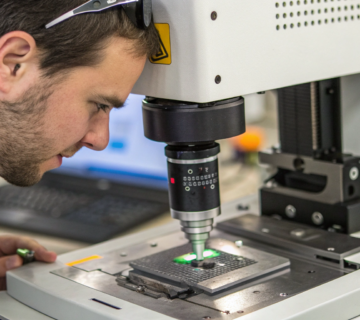Will the different thermal expansion coefficients of ceramic and metal cause joint failure?
When I discuss joining ceramic parts to metal parts, one question comes up very often. People ask about the different ways ceramic and metal expand when heated. They want to know if this difference will cause the joint to break. It is a very good question, and it points to a key challenge in making these types of components. Yes, the different thermal expansion properties are a concern, but engineers have developed ways to handle this problem reliably. This article explains the issue and how we solve it.
Why the stress caused by different extensions?
The main problem is the mechanical stress that happens at the joint because the ceramic and metal expand or contract by different amounts when the temperature changes.
This is a problem because this stress can be very high. If the stress is bigger than the strength of the joint or the materials near the joint, something will break. This might mean the joint itself cracks, the ceramic material right next to the joint cracks, or the metal part deforms. When a joint breaks in a critical component, it can lose its seal (if it was a hermetic seal), it can lose its electrical connection, or it can lose its mechanical support. This causes the whole device or system to fail. This risk is worse when the temperature changes a lot or very quickly, or if the parts are large.
Yes, the difference in how ceramic and metal materials expand and contract with temperature changes does create stress at the joint interface. If this stress is not managed correctly through material selection, design, and manufacturing, it is a primary cause of joint failure in ceramic-to-metal assemblies during thermal cycling.
How do connecting materials need to respond?
The material used to stick the ceramic and metal together is key. It sits right between the two materials with different expansion rates.
This is a problem because the joining material, often a braze alloy1 for strong, hermetic seals, must be able to handle the stress passed to it by both the ceramic and the metal. If the braze alloy is too brittle, it will just crack when pulled or pushed by the expanding and contracting parts. If it is too weak, it will fail mechanically. The joining material needs properties that let it flex or deform slightly without breaking or losing its seal integrity during temperature cycles.
The material chosen for the joint, such as a specific braze alloy, must have properties that allow it to absorb or tolerate the stress caused by the CTE mismatch between the ceramic and the metal. Specialized ductile braze alloys are often used because they can deform slightly under stress without cracking, maintaining the integrity of the joint.
Does design choice matter for managing stress?
The shape of the parts being joined and the design of the joint itself have a big impact on how stress is distributed.
This is a problem because some joint designs put maximum stress right at the most vulnerable points of the ceramic or the braze joint. A simple flat "butt" joint, where the ends are just put together, creates very high stress concentrations. Without a smart design, even a good braze material might fail, or the ceramic, which is strong in compression but weaker in tension, might crack from pulling forces. Poor design makes the component unreliable under thermal stress.
Engineering design plays a critical role in managing CTE mismatch stress. Joint geometries like using metal sleeves or cups that fit around the ceramic part (often putting the ceramic in beneficial compression), or using intermediate layers of metal with graded CTEs, help distribute the stress over a larger area or absorb it, preventing stress concentration at the weak points.
Does choosing the right material help much?
The actual CTE values of the ceramic and the metal being joined directly affect the amount of stress created.
This is a problem because if you pair a ceramic with a very low CTE (like some specialized ceramics) with a metal that has a very high CTE (like aluminum), the stress difference will be huge. It can be very difficult, sometimes impossible, to create a reliable joint for a wide temperature range if the material CTEs are extremely far apart. Choosing materials without considering their CTE match increases the risk of failure.
Selecting ceramic and metal materials that have Coefficient of Thermal Expansion2 values as close as possible helps to minimize the magnitude of the stress generated in the first place. Engineers often choose specific alloys like Kovar (an iron-nickel-cobalt alloy) when joining to alumina, because Kovar’s CTE is a relatively good match for alumina’s CTE.
| Material | Typical CTE ($\times 10^{-6} /°C$) | Material Type |
|---|---|---|
| Alumina (96%) | 6.5 – 7.5 | Ceramic |
| Aluminum Nitride | 4.5 – 5.5 | Ceramic |
| Kovar | 5.0 – 6.0 | Metal Alloy |
| Stainless Steel | 10.0 – 17.0 | Metal Alloy |
| Copper | 16.0 – 17.0 | Metal |
How the Joint is Made Affects Strength?
The actual process used to create the joint, like brazing, involves heating and cooling the materials. This process itself can introduce stress or defects.
This is a problem because if the heating and cooling rates during brazing are too fast, it can create residual stresses in the joint even before the part is used in the application. Poor cleaning of surfaces, incorrect braze alloy amount, or voids (empty spaces) in the braze joint from a bad process create weak spots. These defects make the joint much more likely to fail under operational thermal cycling later on.
Controlling the manufacturing process, particularly the heating and cooling profiles during brazing, is crucial. Slow, controlled cooling allows stresses to relax as the materials contract. Proper surface preparation, assembly, and brazing parameters ensure the braze joint is complete, strong, and free of defects or excessive residual stress from the manufacturing process itself.
Does the shape of the part matter?
The mechanical design of the parts being joined affects how well the seal handles stress.
This is a problem because some shapes put a lot of stress right on the seal area, especially from CTE mismatch. If the design creates points where stress concentrates heavily, even a strong braze and good process might not prevent failure, especially in the brittle ceramic near the joint. Simple flat "butt" joints are often poor designs for handling thermal stress compared to others. Poor design undermines the potential for a reliable seal.
Effective design is crucial for seal reliability. Joint geometries should be designed to manage stresses, particularly those caused by CTE mismatch. Designs that place the ceramic in compression (which it handles well) rather than tension, use transition pieces (like Kovar), or have specific shapes that distribute stress over a larger area help ensure the seal remains intact under operational loads and thermal cycles.

How to Know the Seal is Good?
After the joint is made, you need to verify that it does not leak before it is used in a critical application.
This is a problem because you cannot see if a seal is truly hermetic just by looking at it. Even a leak so small it cannot be seen with a microscope can still allow enough gas or moisture to pass through over time to cause a device failure, especially in vacuum or sensitive electronic applications. Relying on visual checks or pressure testing alone is not enough for high-reliability seals.
Ensuring a reliable seal requires specific, sensitive testing. Hermeticity is proven by performing quantitative leak tests. The most common method is Helium Mass Spectrometry Leak Testing3. This involves placing the part in a test chamber and checking if tiny helium atoms (which can pass through very small leaks) are detected, measuring the leak rate. This confirms the seal meets strict hermeticity standards.
Do ceramic surfaces bond well?
The surface of a plain ceramic, like alumina, is not chemically compatible with common metal joining materials like solders or braze alloys for strong bonding.
This is a problem because if you try to apply molten metal (like braze alloy) directly to bare ceramic, it will not spread out evenly. It will tend to bead up, similar to how water beads on a waxed surface. This poor "wetting" means the metal does not get close enough to the ceramic surface atoms to form a strong chemical bond. The resulting joint will be weak, uneven, and full of microscopic gaps, incapable of providing reliable mechanical strength or a hermetic seal4.
Bare ceramic surfaces lack the necessary chemical or structural characteristics to be properly wetted by and bond strongly with standard metal braze alloys or solders. This prevents the formation of a continuous, robust joint required for strength and sealing without surface modification.
Why is the brazing process enabled?
High-reliability ceramic-to-metal seals are often made using high-temperature brazing because it creates very strong, permanent bonds. This process requires the molten braze alloy to flow correctly.
This is a problem because, as mentioned, bare ceramic does not promote this flow. Without the metallization acting as a wetting layer, the molten braze alloy cannot spread out properly over the ceramic surface during the high-temperature brazing process. It will not fill the entire joint area, leaving voids and discontinuities in the bond line. This prevents the formation of the continuous, sealed joint that brazing is meant to create.
The metallization layer provides a surface that the molten braze alloy can easily "wet" and flow over during the brazing cycle. This allows the braze alloy to spread out evenly, fill the joint gap completely, and form a continuous, uniform bond line along the entire intended sealing perimeter between the ceramic and the metal.
How do you ensure a leak-free path?
For applications requiring hermeticity (no leaks), the joint must be completely impermeable to gases and liquids.
This is a problem because even microscopic voids or incomplete bonding areas within the joint can act as leak paths. If the braze alloy does not fully and continuously wet the ceramic surface (which happens without metallization), tiny channels will exist at that interface. These channels allow gases or liquids to slowly seep through over time, compromising vacuum integrity, allowing moisture ingress into sensitive electronics, or causing pressure loss.
By enabling the braze alloy to properly wet the ceramic surface and form a continuous, void-free bond line along the entire joint perimeter during brazing, the metallization process5 is fundamental to achieving a hermetic seal. It eliminates the microscopic gaps at the ceramic-braze interface that would otherwise act as leak paths.
Common Metallization Methods
Two widely used metallization approaches highlight how a bondable surface is created:
- Moly-Manganese (Mo-Mn): This is common for alumina. A paste containing Molybdenum and Manganese oxides is applied to the ceramic and fired at high temperature. This creates a porous, reacted layer. Then, a plating layer (usually Nickel) is added over the Mo-Mn. The braze alloy wets the nickel plating and reacts with the Mo-Mn layer during brazing.
- Active Brazing Alloys (ABAs)6: These are braze alloys (like Ag-Cu-Ti or Au-Ni-Ti) that contain a reactive element (like Titanium or Zirconium). When molten, the active element in the braze alloy reacts directly with the ceramic surface, creating a thin reaction layer that allows the rest of the braze alloy to bond and wet the ceramic without needing a separate metallization firing step beforehand.
| Method | Process | Ceramic Surface Before Braze | Key To Bonding With Braze |
|---|---|---|---|
| Moly-Manganese | Firing Mo-Mn paste + Plating Nickel | Plated Nickel layer on Mo-Mn | Braze wets Nickel, reacts with Mo-Mn |
| Active Brazing | Braze Alloy contains Reactive Element | Bare Ceramic | Reactive Element bonds directly |
Conclusion
The question "Will the different thermal expansion coefficients of ceramic and metal cause joint failure?" highlights a fundamental challenge in joining these dissimilar materials. Yes, the different expansion rates create stress at the joint interface during temperature changes, and this can absolutely lead to failure if not addressed. However, this is a known engineering problem, not a barrier. Through careful selection of materials with compatible CTEs, smart joint design, using appropriate braze alloys, and precise control of the manufacturing process, engineers can effectively manage this stress. These techniques allow for the creation of highly reliable, strong, and hermetic ceramic-to-metal joints that perform successfully even under wide and repeated temperature variations in critical applications.
-
Exploring braze alloys helps in selecting the right material for strong, reliable joints that can withstand thermal stress. ↩
-
Understanding CTE is crucial for engineers to select materials that minimize stress and prevent joint failure in ceramic-metal assemblies. ↩
-
This testing method is essential for verifying the integrity of seals in critical applications, ensuring reliability and performance. ↩
-
Understanding hermetic seals is crucial for applications requiring leak-proof joints, especially in electronics and sensitive environments. ↩
-
Exploring the metallization process reveals how it enables strong bonds in ceramic-to-metal joints, essential for reliability. ↩
-
Learning about ABAs can enhance your knowledge of advanced bonding techniques, improving joint strength and reliability. ↩










No comment